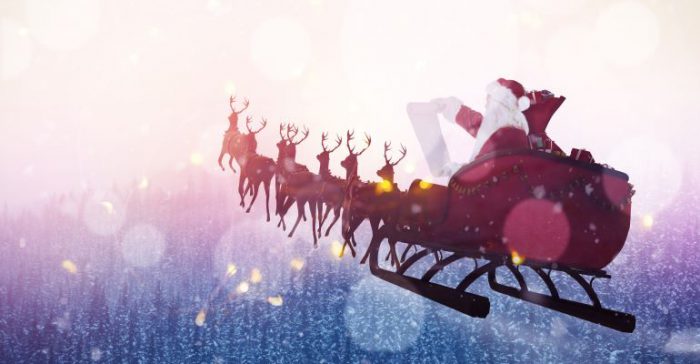Written by Taylor Patterson, ERS
Santa Claus is coming to town! The legend of Santa bringing toys to all the good little girls and boys on Christmas Eve is familiar to us all: Santa visits every home in the world, riding on his sleigh. But does this 24-hour delivery ride have a greater environmental impact, and is Santa using the most efficient fuel source for his sleigh? Let’s take a look at each component and figure out the best sustainability option. Is it the magical reindeer and their fearless leader with a red nose so bright? Or is it the Kringle 3000, a 500-reindeer-powered jet engine invented by Papa Elf and put back together by a heroic elf named Buddy while in the middle of Central Park? Or is it really just good old fashioned Christmas spirit? Does Santa’s annual journey each Christmas in fact worsen our climate crisis? Can Christmas be saved?!
Option 1: Magical Reindeer
Sure, Dasher, Dancer, Prancer, Vixon, Comet, Cupid, Donner, Blitzen, and Rudolph might only emit natural gases into Earth’s atmosphere during their tiring journey pulling Santa’s sleigh, but what about the 364 days before? It takes an abundance of energy and fuel to deliver carrots to the North Pole to prepare the reindeer for their big night. The level of sustainability used in the farming practices to grow those carrots is also questionable. On top of that, the reindeer need a lot of water – is it filtered with electricity from the grid or imported through a pipeline running to the North Pole? Is it bottled, leaving plastic waste? And let’s think about our pal Rudolph, his nose so bright. What keeps that thing shining? Does his flashlight nose run on traditional lithium-ion batteries? It sure doesn’t run on solar! These nine reindeer may appear energy efficient, but their upkeep and maintenance have several gray areas nearing environmental malpractices and could contribute to the current climate crisis.
Option 2: The Kringle 3000
A 500 RP (reindeer-power) jet turbine engine – isn’t that something! But is it sustainable? According to science, Santa travels 122 million miles over 24 hours to stop at every household and deliver toys. To travel this distance, he must travel at top speed, which explains the 500 RP engine. The conversion factor for reindeer-power to horsepower is .63, which would mean that the Kringle 3000 operates at 315 horsepower, or 235 kWh. The 235 kWh energy needed to fly Santa’s sleigh multiplied by the 24 hours it takes to deliver toys results in 5,640 kWh expended each year for Santa’s annual trip – not an efficient option! And the Kringle 3000 is not only environmentally irresponsible but also unreliable! Hence, falling off in the middle of Central Park and almost getting Santa arrested by the Central Park Rangers… what a headline that would’ve been!
Option 3: Christmas Spirit
The last topic of discussion is this Christmas spirit thing, a tale as old as time. The ways that someone can show Christmas spirit are endless: tree decorating, hanging stockings, wrapping presents, giving to others, watching your favorite holiday classics, and so many more. However, the best way to spread Christmas cheer is singing loud for all to hear. Even just the slightest bit of Christmas spirit can brighten not only your own holiday but also the holiday season for those lucky enough to share it with you. If everyone showed a little holiday spirit, the Clausometer could register more than enough Christmas spirit to power Santa’s sleigh and fly him around the world. The best part is that it takes zero carbon emissions, fossil fuels, electricity, battery power, or any other type of environmental hinderance to be kind, generous, and merry.
There you have it, folks. Christmas spirit is Santa’s sustainable secret – which means it is our job to sing loud, sing proud, and spread magical cheer wherever the holiday season brings us.
